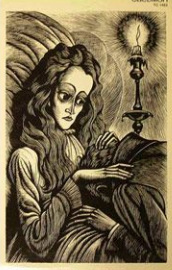Ligeia
How have Poe's works been affected by the fast evolution of science and more specifically, the destruction of the field of Physiognomy?

Ligeia laying in bed, struck with illness.
Ligeia is the story that follows an unnamed character and his wife Ligeia. She recites "The Conqueror Worm" before she dies and suggests that life is sustainable only through willpower. The narrator then marries the Lady Rowena after Ligeia's death, but Rowena becomes ill and she dies as well. The narrator stays with her body overnight, and Rowena slowly comes back from the dead. Through the narrator's opium-induced hallucination, he sees Rowena rise from the dead as his beloved first wife Ligeia.
The narrator at first when
describing Ligeia, saying “in stature she was tall, somewhat slender”
then goes to say that she had the “radiance of an opium-dream.”
He then describes her in great detail for the next couple paragraphs.
The deep description of Ligeia's face goes back to Poe's study of physiognomy. This is the assessment of a person's character or personality from their outer appearance, especially the face. It is also said that phrenology, the study of the indentions in the skull, is a branch of physiognomy. In the article "Weird Science, Weirder Unity: Phrenology and Physiognomy in Edgar Allan Poe", it is discussed that Poe uses physiognomy terms so loosely that it is obvious he expected his readers to be aware of the now pseudo-science. Another short story written by Poe that lies heavily on physiognomy and the appearance of people is The Man of the Crowd. One thing the narrator specifically mentions is “the contour of the lofty and pale forehead” as displaying a “gentle prominence in the regions above the temples.” Physiognomists believe that the brain is divided up into many organs with different characteristics. Ideality lies precisely on the area described but he says regions, referring to more than one organ. Three other large organs were theorized to be in the same area as Ideality: Acquisitiveness (greed to increase one's possessions), Secretiveness, and Destructiveness. Also, two tiny organs reside in that area as well: Alimentiveness (gluttonous appetites) and “the love of life”. Of the five organs in that region, the last and unnamed organ best describes Ligeia. The narrator's mention of the regions above Ligeia's temples could have been a foreshadow of her return through Rowena's body.
The deep description of Ligeia's face goes back to Poe's study of physiognomy. This is the assessment of a person's character or personality from their outer appearance, especially the face. It is also said that phrenology, the study of the indentions in the skull, is a branch of physiognomy. In the article "Weird Science, Weirder Unity: Phrenology and Physiognomy in Edgar Allan Poe", it is discussed that Poe uses physiognomy terms so loosely that it is obvious he expected his readers to be aware of the now pseudo-science. Another short story written by Poe that lies heavily on physiognomy and the appearance of people is The Man of the Crowd. One thing the narrator specifically mentions is “the contour of the lofty and pale forehead” as displaying a “gentle prominence in the regions above the temples.” Physiognomists believe that the brain is divided up into many organs with different characteristics. Ideality lies precisely on the area described but he says regions, referring to more than one organ. Three other large organs were theorized to be in the same area as Ideality: Acquisitiveness (greed to increase one's possessions), Secretiveness, and Destructiveness. Also, two tiny organs reside in that area as well: Alimentiveness (gluttonous appetites) and “the love of life”. Of the five organs in that region, the last and unnamed organ best describes Ligeia. The narrator's mention of the regions above Ligeia's temples could have been a foreshadow of her return through Rowena's body.
Conclusion
The readers during Poe's time that understood phrenology would have received a deeper meaning behind his works. Phrenology was widely believed until the end of the nineteenth century, but during the 21st century, readers can not understand the reference of the "prominence in the regions above the temples." Readers could even wrongly interpret the text into poor physical images instead of deeper emotional characteristics. The destruction of the science field phrenology lead to a loss of significance of the minute details of Poe's, and numerous other artists and novelists' work.
